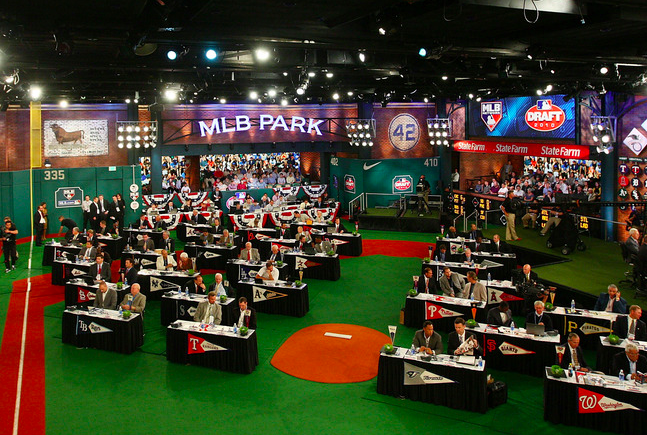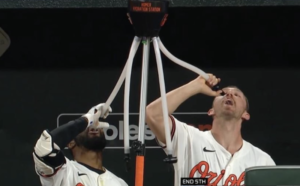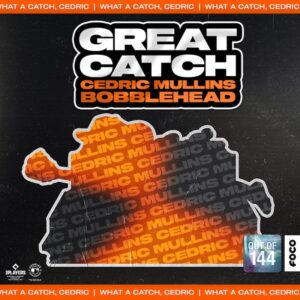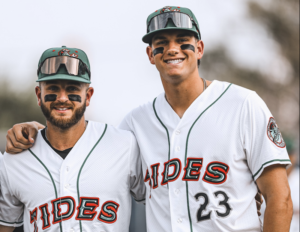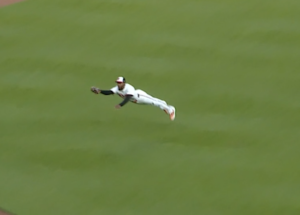In last week’s article, I mentioned how the advantage of “going under slot” is the ability to get more young talent in a farm system than just picking best player available. Who are those players, though? If a team feels like they can get equal overall talent by getting not-as-good players at their first pick, then those later players better are pretty good, right?
Well, this is why I am here today. I will be breaking down my favorite options for an over-slot pick at either the Orioles’ comp pick or second round pick. This doesn’t mean they can’t get these players if they give that first pick over $8 million; it just means that they are more likely to get them.
I feel this is essential because these prospects need more spotlight on them, especially if Mike Elias is going to go under-slot at one. It was a bit of a challenge to come up with names for this list. First, it is tough to tell who will make it through the cracks of the first round, as the Draft is unpredictable, and these players might not even be here when the Orioles do pick.
So here is what I did: I looked at trends from past drafts to see if I could predict the future of who exactly could fall. I found out that most of the prospects that fell in the draft have two things in common: high school pitchers who are projects, and who have commitments to big-time schools like Vanderbilt.
Using this criterion, I have compiled a list of five high school prospects that intrigue me the most if they are available in the comp or second round.
So here are the over-slot options for the Orioles if they fall.
Noah Shultz, SP, HS: Oswego East, (IL): 6’9, 220 lb
Noah Shultz is a very intriguing arm in this draft. Schulz has impressed scouts due to his build and unique delivery that has him throwing from a low-three-quarters arm slot. Shultz is much more polished than someone at his age should be. He has an elite slider that is nasty. The slider is unique to Shultz because of his height and arm slot, which give it much more run than other sliders. Lefties have no shot at hitting Shultz because of how his slider works and because he can also control it well; you might as well go up in the box with no bat.
His fastball is pretty good, but my issue is his low velocity. He sat only 89-92 mph in most of his showcases, topping out at 94. This can be viewed as a positive as he hasn’t maxed out yet and has much more control than most high school pitchers, so adding velocity shouldn’t be hard. On the other hand, with someone with this build and height, you expect him to throw a little harder, and I shouldn’t have to explain why a low-velocity fastball isn’t good. Shultz’s change-up is also a decent offering, but it isn’t as good as his slider.
So why is Shultz not considered a first-round prospect? My concern with Shultz is his lack of velocity and good, not great control on his other pitches outside his breaking ball. Look, I am willing to accept a high school pitcher isn’t going to be the most polished in his control, but when you don’t have elite velocity, it becomes a lot harder for me to accept his faults in command of his other pitches.
Another reason is that he has barely pitched at all this year and has a massive commitment to Vanderbilt. It will take a lot of money, and I am talking $2 million-plus, to get Shultz, and if I have other options, Shultz won’t be my first choice.
I like Shultz, but his lack of velocity and huge price tag just push him down on the list for me.
Cole Phillips, SP, HS: Boerne, (TX): 6’3, 200 lb
If there were a pitcher that has the most significant question mark on this list, it would have to be Cole Phillips. Phillips was making some serious strides in the Spring when he showed a much-improved fastball velocity and run on his pitches. The Texas high school pitcher looked like an easy lock to be a first-round pick until he got hit with a Tommy John Surgery in April. He showed some awe-inspiring growth going from a pitcher with good stuff and command with solid velocity to someone who sat in the mid-90s touching triple digits. It is tragic that he required Tommy John Surgery because he had good data on his pitches and improved velocity.
Phillips is talented enough to go in the first two rounds, but it remains to be seen what teams think after the injury.
If Phillips is there in the comp round, he would be near the top of my list of prospects. I don’t care about the Tommy John Surgery – sign me up.
Cole Young, SS, HS: North Allegany, (PA): 6’0, 180 lb
This part of PA doesn’t usually produce that much talent, but I will make an exception for this prospect. Cole Young has one of the better hit tools in this draft class. Young uses his left-handed swing to make a ton of contact to just put the ball and play. Young also has good speed and fielding at shortstop, mixed in with his solid throwing arm. The issue for me is his lack of power. He could grow into it as he gets older, but I have major concerns over how much power he will hit for.
Young’s overall profile doesn’t fit perfectly with the over-slot strategy. When you go over-slot, you want a prospect with tools that can flash and impress. Young’s hit tool is very good, but nothing else impresses me. Especially if you have to give him over $2 million. I like Young, but I don’t know if I would give him an over-slot deal. He would be at the bottom of the list for me.
Andrew Dutkanych IV, SP, HS: Brebeuf Jesuit, (IN): 6’3, 210 lb
Indiana hasn’t produced much recent talent from high school ranks, but Andrew Dutkanych should break that mold. Dutk has a great repertoire, but his main offerings are his fastball and slider. His slider is a true wipeout pitch that can be straight filth. His fastball maxes out at 97 right now, and he controls it well and mixes it in with his slider. He also features a good curveball and a change-up that he doesn’t usually use.
However, he does best with his crystal-clean delivery and mechanics that show that he probably won’t be an injury risk moving forward.
He is just a great pitcher with great offerings and amazing mechanics. He reminds me of Walker Buehler with his Vanderbilt commit and what he brings.
The Vanderbilt commitment will be challenging to work with, and he will demand a ton of money if he makes it past the first round. If he is there, I would be down, and he is definitely near the top of this list for me.
Brandon Barriera, SP, HS: American Heritage, (FL): 6’2, 180 lb
Barriera is a projectable high school prospect. He attacks the strike zone very well with his repertoire. Barriera impressed scouts during his summer showcase season, showing he was among his class’s best high school pitchers. He was well on his way to proving it again, but he was shut down in mid-April, not due to injury but because he wanted to be cautious. While he won’t light up the radar gun consistently, it will be hard to find any arm that has better stuff. His fastball is very good and has a ton of run with good velocity. His change-up is a great offering, and he can be deceptive. His slider might be his best pitch as he misses a ton of bats with it, and he can mix it well with his fastball and change-up. Barriera isn’t afraid to attack the zone; he will attack with strikes and won’t nibble.
He won’t come cheap as he has a Vanderbilt commit, but I would love to take him if he makes it. He reminds me of a left-handed Carter Baumler, as he will probably be able to add velocity as he gets older.
Thank you for reading, and I will see you guys next week.

